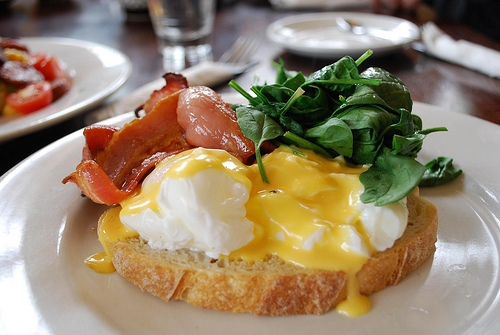Eggs Benedict Day 2024 is on Tuesday, April 16, 2024: Mothers day.What are you cooking for mom?
Tuesday, April 16, 2024 is Eggs Benedict Day 2024. April 16 is National Eggs Benedict Day National Eggs Benedict Day
As an Amazon Associate I earn from qualifying purchases.

Eggs Benedict Day is definitely an excuse to possess a tasty treat! Eggs Benedict is typically produced from a cut in half British muffin, capped with pork (or sometimes sausage), poached eggs along with a hollandaise sauce. Everyone has their very own versions, versions and favourites which change and swap out virtually all the components, by using bread rather than muffins, to cheese rather than sauce, or adding extra elements for example paprika. Regardless of the choice, it's usually scrumptious!

The Menu:
Eggs Benedict with Canadian Bacon
Mediterranean Quiche
Belgian Waffles with Blueberry Syrup
Stuffed French Toast with Berry Filling
Butter Rum Apples
The Perfect Fruit Compote
-------------
Traditional Eggs Benedict
1 teaspoon vinegar
4 eggs
4 thin slices Canadian bacon
2 English muffins
Hollandaise sauce:
3 egg yolks
1 tablespoon hot water
1 tablespoon lemon juice
1 stick unsalted butter, melted and hot
Salt and pepper
Paprika
Chopped parsley
In a large skillet, bring 2 inches of water and the vinegar to a boil. Crack one egg into a glass. Reduce water to a simmer and pour egg into water in one quick motion. Quickly add remaining eggs. Let eggs cook for 4-5 minutes. The white should be firm but the yellow should be runny. Remove eggs with a slotted spoon and drain on a paper towel.
In a non-stick skillet heat the bacon until warm. Toast the English muffins until golden.
For the sauce: Place yolks, water and lemon juice into blender. Blend for 1 minute. With blender running, pour butter through open hole of blender lid. Season with salt and pepper and keep warm.
To assemble eggs benedict: Top each muffin with bacon and a poached egg. Pour warm sauce over and garnish with paprika and chopped parsley.
Alternatives: Vegetarian: Substitute wilted spinach and a grilled tomato for the ham.
-------------------------
Mediterranean Quiche
2 tablespoons unsalted butter
1 cup sliced yellow onions
1 medium zucchini, chopped
1/4 pound mushrooms, wiped clean and sliced
1 teaspoon minced garlic
4 ounces oil-packed sun-dried tomatoes, drained and chopped
3 tablespoons chopped fresh basil
2 teaspoons chopped fresh thyme
1/2 teaspoon salt
1/4 teaspoon freshly ground black pepper
3 large eggs
1 1/4 cups half-and-half
1/2 cup grated Gruyere
1/2 teaspoon crushed red pepper
Savory pie crust, recipe follows
3 ounces goat cheese, crumbled
Preheat the oven to 375 degrees F.
In a large skillet melt the butter over medium-high heat. Add the onions and zucchini and cook, stirring, for 6 minutes. Add the mushrooms and cook, stirring, until the liquid is rendered and the vegetables are wilted, about 10 minutes.
Add the garlic and cook for 1 minute.
Add the tomatoes, basil, and thyme and season lightly with salt and pepper. Cook, stirring, for 1 minute. Remove from the heat and let cool.
In a bowl, beat the eggs and half-and-half together. Add the salt, pepper, grated Gruyere, and crushed red pepper.
Spoon the vegetable mixture into the prepared piecrust, pour in the egg mixture, and crumble the goat cheese on top. Bake for 25 to 30 minutes until set. Remove from the oven and let cool for 30 minutes before serving.
Savory Pie Crust:
8 ounces flour (about 1 1/2 cups plus 2 tablespoons)
1/2 teaspoon salt
4 ounces (1 stick) cold butter, cut into 1/4-inch pieces
2 tablespoons solid vegetable shortening
3 tablespoons ice water
Sift the flour and salt into a large mixing bowl. Incorporate the butter and shortening by hand, working the fat into the flour with your fingertips until the dough starts to come together and form small pea shapes. Work the ice water into the dough until it just comes together, being careful not to over mix.
Form the crust into a disk shape, wrap tightly in plastic wrap, and place in the refrigerator to rest for at least 30 minutes. Turn onto a lightly floured surface and roll out into an 11-inch circle. Fit into a 9-inch pie pan, trimming any excess and crimping the edges to fit the pan. Cover the bottom with parchment paper and pie weights or uncooked beans, and bake for 12 minutes. Remove from the oven and uncover. Let cool slightly on a wire rack before filling.
Yield: 1 crust
Belgian Waffles with Blueberry Syrup
In a large mixing bowl, prepare your favorite waffle mix according to package directions.
Preheat waffle iron according to manufacturer's guidelines. Lightly spray the waffle iron with nonstick spray. Using a 4-ounce ladle or 1/2 cup measure, ladle batter for waffle into the iron, spreading evenly. Close the waffle iron and cook for 2 minutes or until waffles are golden and the steaming stops. Repeat with remaining batter. Serve with Whipped Cream and Blueberry Syrup.
BLUEBERRY SYRUP:
1 tablespoons butter
1 pint blueberries
1/4 cup granulated sugar
1/2 lemon, juiced
In a small saucepan over medium heat, combine butter, blueberries, sugar and lemon. Stir gently until the berries break down and release their natural juice. The consistency should remain a bit chunky. Serve hot over waffles.
WHIPPED CREAM:
1 cup heavy cream, chilled
2 tablespoons granulated sugar
1 teaspoon natural vanilla extract
Using a hand-held electric beater on high speed, beat the cream in a chilled stainless steel bowl until it begins to thicken.
Add sugar and vanilla. Continue to beat until the cream forms stiff peaks. Refrigerate until ready to use.
------------------
Stuffed French Toast with Berry Filling
One 8-ounce package cream cheese
1 tsp milk or cream
1 cup chopped fresh strawberries or raspberries
1/4 cup strawberry or raspberry preserves
1/2 cup chopped toasted nuts, pecans or walnuts
2 Tbsp Chambord
In a medium size bowl, combine the cream cheese and milk until smooth. Stir in the next 4 ingredients.
1 loaf French Bread
Cut bread into 10-12 1 1/2 inch diagonal slices with serrated knife. With sharp Paring knife cut a pocket in the top of each. Fill each with 1 1/2 Tbsp filling. Place in zip lock bags and freeze.
---------
French Toast Dip
4 eggs
2 cups milk or half and half
3/4 tsp vanilla
3/4 tsp nutmeg
1 tsp cinnamon
Beat eggs, add milk and seasonings. Dip the partially thawed bread into the egg mixture and allow to get moderately soaked on both sides, drain excess before grilling. Generously coat grill with vegetable oil and a little butter. Cook each side until brown.
Garnish
Powdered sugar, as needed for garnishing
1 cup strawberries, sliced for garnishing
1/2 cup chopped, toasted nuts, pecans or walnuts for garnishing
Serve 2 or 3 slices overlapping on plate with powdered sugar and sliced strawberries. Sprinkle nuts over the top.
----------------------
Butter Rum Apples
4 Gravenstein apples
1/2 cup dark rum
1/2 cup water
1 cup sugar
1 Tbsp instant coffee
1/4 tsp cinnamon
1/2 cup butter
Peel, core and halve the apples. In a medium pot, heat the rum, water, sugar, instant coffee, cinnamon and butter until bubbly. Simmer for 10 minutes. Add apples and cook apples until tender, basting apples occasionally. Serve apple one half apple each with a dollop of whipped cream.
---------------
The Perfect Fruit Compote
Sauce:
1/2 cup sugar
2 Tbsp. cornstarch
3/4 cup pineapple juice
1/2 cup orange juice
2 Tbsp. lemon juice
Add all ingredients together and cook until thickens, stirring constantly. Put aside to cool.
Fruit Mixture:
20 oz. pineapple chunks
11 oz. Mandarin oranges
3-4 diced apples
2-3 bananas
1/2 cup cherries or grapes for color
Optional other fruits in season may be added. Fruits, as bananas and apples, will not turn their color in this sauce.
-------------
Fireside Coffee Mix
2 c. non-dairy coffee creamer
1 1/2 c. hot cocoa mix (dry)
1 1/2 c. instant coffee
1 1/2 c sugar
1 teaspoon cinnamon
1/2 teaspoon nutmeg
Combine all ingredients. Store in an airtight container.
For one cup:
2 tablespoons + 1 tsp. of mix
Add water
Chilled champagne

What are some breakfast-in-bed Mother's Day recipes?
The Menu:
Eggs Benedict with Canadian Bacon
Mediterranean Quiche
Belgian Waffles with Blueberry Syrup
Stuffed French Toast with Berry Filling
Butter Rum Apples
The Perfect Fruit Compote
-------------
Traditional Eggs Benedict
1 teaspoon vinegar
4 eggs
4 thin slices Canadian bacon
2 English muffins
Hollandaise sauce:
3 egg yolks
1 tablespoon hot water
1 tablespoon lemon juice
1 stick unsalted butter, melted and hot
Salt and pepper
Paprika
Chopped parsley
In a large skillet, bring 2 inches of water and the vinegar to a boil. Crack one egg into a glass. Reduce water to a simmer and pour egg into water in one quick motion. Quickly add remaining eggs. Let eggs cook for 4-5 minutes. The white should be firm but the yellow should be runny. Remove eggs with a slotted spoon and drain on a paper towel.
In a non-stick skillet heat the bacon until warm. Toast the English muffins until golden.
For the sauce: Place yolks, water and lemon juice into blender. Blend for 1 minute. With blender running, pour butter through open hole of blender lid. Season with salt and pepper and keep warm.
To assemble eggs benedict: Top each muffin with bacon and a poached egg. Pour warm sauce over and garnish with paprika and chopped parsley.
Alternatives: Vegetarian: Substitute wilted spinach and a grilled tomato for the ham.
-------------------------
Mediterranean Quiche
2 tablespoons unsalted butter
1 cup sliced yellow onions
1 medium zucchini, chopped
1/4 pound mushrooms, wiped clean and sliced
1 teaspoon minced garlic
4 ounces oil-packed sun-dried tomatoes, drained and chopped
3 tablespoons chopped fresh basil
2 teaspoons chopped fresh thyme
1/2 teaspoon salt
1/4 teaspoon freshly ground black pepper
3 large eggs
1 1/4 cups half-and-half
1/2 cup grated Gruyere
1/2 teaspoon crushed red pepper
Savory pie crust, recipe follows
3 ounces goat cheese, crumbled
Preheat the oven to 375 degrees F.
In a large skillet melt the butter over medium-high heat. Add the onions and zucchini and cook, stirring, for 6 minutes. Add the mushrooms and cook, stirring, until the liquid is rendered and the vegetables are wilted, about 10 minutes.
Add the garlic and cook for 1 minute.
Add the tomatoes, basil, and thyme and season lightly with salt and pepper. Cook, stirring, for 1 minute. Remove from the heat and let cool.
In a bowl, beat the eggs and half-and-half together. Add the salt, pepper, grated Gruyere, and crushed red pepper.
Spoon the vegetable mixture into the prepared piecrust, pour in the egg mixture, and crumble the goat cheese on top. Bake for 25 to 30 minutes until set. Remove from the oven and let cool for 30 minutes before serving.
Savory Pie Crust:
8 ounces flour (about 1 1/2 cups plus 2 tablespoons)
1/2 teaspoon salt
4 ounces (1 stick) cold butter, cut into 1/4-inch pieces
2 tablespoons solid vegetable shortening
3 tablespoons ice water
Sift the flour and salt into a large mixing bowl. Incorporate the butter and shortening by hand, working the fat into the flour with your fingertips until the dough starts to come together and form small pea shapes. Work the ice water into the dough until it just comes together, being careful not to over mix.
Form the crust into a disk shape, wrap tightly in plastic wrap, and place in the refrigerator to rest for at least 30 minutes. Turn onto a lightly floured surface and roll out into an 11-inch circle. Fit into a 9-inch pie pan, trimming any excess and crimping the edges to fit the pan. Cover the bottom with parchment paper and pie weights or uncooked beans, and bake for 12 minutes. Remove from the oven and uncover. Let cool slightly on a wire rack before filling.
Yield: 1 crust
Belgian Waffles with Blueberry Syrup
In a large mixing bowl, prepare your favorite waffle mix according to package directions.
Preheat waffle iron according to manufacturer's guidelines. Lightly spray the waffle iron with nonstick spray. Using a 4-ounce ladle or 1/2 cup measure, ladle batter for waffle into the iron, spreading evenly. Close the waffle iron and cook for 2 minutes or until waffles are golden and the steaming stops. Repeat with remaining batter. Serve with Whipped Cream and Blueberry Syrup.
BLUEBERRY SYRUP:
1 tablespoons butter
1 pint blueberries
1/4 cup granulated sugar
1/2 lemon, juiced
In a small saucepan over medium heat, combine butter, blueberries, sugar and lemon. Stir gently until the berries break down and release their natural juice. The consistency should remain a bit chunky. Serve hot over waffles.
WHIPPED CREAM:
1 cup heavy cream, chilled
2 tablespoons granulated sugar
1 teaspoon natural vanilla extract
Using a hand-held electric beater on high speed, beat the cream in a chilled stainless steel bowl until it begins to thicken.
Add sugar and vanilla. Continue to beat until the cream forms stiff peaks. Refrigerate until ready to use.
------------------
Stuffed French Toast with Berry Filling
One 8-ounce package cream cheese
1 tsp milk or cream
1 cup chopped fresh strawberries or raspberries
1/4 cup strawberry or raspberry preserves
1/2 cup chopped toasted nuts, pecans or walnuts
2 Tbsp Chambord
In a medium size bowl, combine the cream cheese and milk until smooth. Stir in the next 4 ingredients.
1 loaf French Bread
Cut bread into 10-12 1 1/2 inch diagonal slices with serrated knife. With sharp Paring knife cut a pocket in the top of each. Fill each with 1 1/2 Tbsp filling. Place in zip lock bags and freeze.
---------
French Toast Dip
4 eggs
2 cups milk or half and half
3/4 tsp vanilla
3/4 tsp nutmeg
1 tsp cinnamon
Beat eggs, add milk and seasonings. Dip the partially thawed bread into the egg mixture and allow to get moderately soaked on both sides, drain excess before grilling. Generously coat grill with vegetable oil and a little butter. Cook each side until brown.
Garnish
Powdered sugar, as needed for garnishing
1 cup strawberries, sliced for garnishing
1/2 cup chopped, toasted nuts, pecans or walnuts for garnishing
Serve 2 or 3 slices overlapping on plate with powdered sugar and sliced strawberries. Sprinkle nuts over the top.
----------------------
Butter Rum Apples
4 Gravenstein apples
1/2 cup dark rum
1/2 cup water
1 cup sugar
1 Tbsp instant coffee
1/4 tsp cinnamon
1/2 cup butter
Peel, core and halve the apples. In a medium pot, heat the rum, water, sugar, instant coffee, cinnamon and butter until bubbly. Simmer for 10 minutes. Add apples and cook apples until tender, basting apples occasionally. Serve apple one half apple each with a dollop of whipped cream.
---------------
The Perfect Fruit Compote
Sauce:
1/2 cup sugar
2 Tbsp. cornstarch
3/4 cup pineapple juice
1/2 cup orange juice
2 Tbsp. lemon juice
Add all ingredients together and cook until thickens, stirring constantly. Put aside to cool.
Fruit Mixture:
20 oz. pineapple chunks
11 oz. Mandarin oranges
3-4 diced apples
2-3 bananas
1/2 cup cherries or grapes for color
Optional other fruits in season may be added. Fruits, as bananas and apples, will not turn their color in this sauce.
-------------
Fireside Coffee Mix
2 c. non-dairy coffee creamer
1 1/2 c. hot cocoa mix (dry)
1 1/2 c. instant coffee
1 1/2 c sugar
1 teaspoon cinnamon
1/2 teaspoon nutmeg
Combine all ingredients. Store in an airtight container.
For one cup:
2 tablespoons + 1 tsp. of mix
Add water
Chilled champagne
hope these help. enjoy.

Where did the name deviled eggs originate?
Food Timeline>eggs
About eggs
Egg symbolism
Deviled eggs
Easter eggs
Eggs Benedict
omelettes
souffle
Western sandwiches Have questions? Ask!
When and why did humans begin consuming eggs?
Humans have been consuming eggs since the dawn of human time. The history is complicated and diverse; the culinary applications are innumerable. When, where, and why have people been eating eggs?
When? Since the beginning of human time.
Where? Wherever eggs could be obtained. Differerent kinds of eggs were/still are eaten in different parts of the world. Ostrich and chicken are the most common.
Why? Because eggs are relatively easy to obtain, excellent protein sources, adaptable to many different types of recipes (from simply boiled, fried, or stuffed to complicated quiche, custards or meringue), and fit the bill for meatless fasting days required by some religions. In this last role? Eggs have been the object of much socio-religious symbolism and tradition. Over time, some groups have encouraged the consumption/decoration of eggs in celebration of certain events. Others have decided eggs are filthy food which must avoided. None of this is arbitrary.
"It is likely that female game birds were, at some time in the early history of man, perceived as a source both of meat and of eggs. Men discovered that by removing from the nest eggs that they did not wish to have hatch (or that they simply wished to eat), they could induce the female jungle fowl to lay additional eggs and, indeed, to continue to lay eggs throught an extended laying season." ---The Chicken Book, Page Smith and Charles Daniel [University of Georgia Press:Athens] 1975 (p. 11-12)
"Eggs have been known to, and enjoyed by, humans for many centuries. Jungle fowl were domesticated in India by 3200 B.C.E. Record from China and Egypt show that fowl were domesticated and laying eggs for human consumption around 1400 B.C.E., and there is archaeoligical evidence for egg consumption dating back to the Neolithic age. The Romans found egg-laying hens in England, Gaul, and among the Germans. The first domesticated fowl reached North America with the second voyage of Columbus in 1493."
---Encyclopedia of Food and Culture, Solomon H. Katz, editor, William Woys Weaver, associate editor [Charles Scribner's Sons:New York] 2003, Volume 1 (p. 558)
How many different kind of eggs are there?
Birds and reptiles lay eggs. Of these, some are consumed by humans. Preferences vary according to place, taste and economic conditions.
"Eggs from many species of fowl (birds) have doubtless been consumed since the very beginning of humankind's stay on earth. In historical times, ancient Romans ate peafowl eggs, and the Chinese were fond of pigeon eggs. Ostrich eggs have been eaten since the day sof the Phoenicians, whereas quail eggs, as hard-cooked, shelf-stable, packaged prdoucts, are now featured on many gourmet food counters in the United States and Japan. Other eggs consumed by various ethnic groups include those from plovers, partridges, gulls, turkeys, pelicans, ducks, and geese. Turtle eggs have been highly prized, and in starvation situations, any eggs, even those of alligators, have been relied upon."
---Cambridge World History of Food, Kenneth F. Kiple and Kriemhild Conee Ornelas [Cambridge University Press:Cambridge] 2000, Volume One (p. 499)
When did people start using eggs in baking and why?
Food historians tell us the practice was ancient but they do not venture an exact place, date, or reason. The domestication of fowl (esp. chicken) greatly increased the availabiltiy of eggs to ancient peoples. This is thought by some to have begun in China in 6,000BC. About chicken.
Culinary evidence confirms breads and cakes using eggs were made by Ancient Egyptian and Roman peoples. The reason most often sited was the recognition that eggs worked as binding (thickening) agents. How did that begin? The food historians to not venture into this territory. Possibly it was a discovery based on trial and error. Many foods and cooking methods (leavened bread, roasted meats, yogurt) were "invented" this way.
"It is clear that Egyptians enjoyed their food. Nobles and priests were particularly well served, with at least forty different kinds of bread and pastries, some raised, some flat, some round, some conical, some plaited. There were some varieties made with honey, others with milk, still others with eggs."
---Food in History, Reay Tannahill [Three Rivers Press:New York] 1988 (p. 53)
"Farming the prolific chicken has allowed us to make eggs a part of our diet without harming its reproductive cycle. However, the very few ancient Greek recipes to mention eggs date from after the time of Pericles, when the chicken was introduced to Africa. It took some times for the habit of using eggs in cooking to catch on. We do hear of thagomata, made from egg whites, and various stuffings using egg yolks. On the other hand the classic cake offered as a sacrifice by the Romans, the libum, called for one egg to a pound of flour. In the Roman period pastry cooks made much use of eggs for desserts as well as cakes. Apicius (25 BC) invented baked custard: milk, honey and eggs beaten and cooked in an eartheware dish on gentle heat. Eggs really made their way into the kitchen with Apicius, who mentioned them frequently in the Ars Magirica. Beaten eggs were used as a thickening and to bind sauces and ragouts; hardboiled eggs became an ingredient of various dishes, sometimes with cheese, but here is no evidence that eggs were eaten just as they were, as a dish in themselves. This does not mean that they were not so eaten; it could simply indicate that they were not thought interesting enough for special mention."
---History of Food, Maguelonne Toussaint-Samat, translated by Anthea Bell [Barnes & Noble Books:New York] 1992 (p. 356)
Ancient Roman libum recipe (ancient translation & modern version)
These sources are good starting points for an understanding of the topic:
The Cambridge World History of Food, Kenneth F. Kiple and Kriemhild Conee Ornelas, Volume One: Chicken eggs [Cambridge University Press:Cambridge] 2000 (p. 499-508)
---includes extensive bibliography for further study; use the index to locate information on other types of eggs
History of Food, Maguelonne Toussaint-Samat [Barnes & Noble:New York] 1992 (p. 355-363)
---uses & customs, including Easter traditions
Food and Drink in Britain: From the Stone Age to the 19th Century, C. Anne Wilson [Academy Chicago:Chicago] 1991 (p. 137-148)
---as they relate to English cookery
Nectar and Ambrosia: An Encyclopedia of Food in World Mythology, Tamra Andrews [ABC-CLIO:Santa Barbara] 2000 (p. 86-87)
---rituals, customs & myths
Need facts, trivia & science? The American Egg Board is the place to go!
--------------------------------------------------------------------------------
Egg symbolism
"Because eggs embody the essence of life, people from ancient times to the modern day have surrounded them with magical beliefs, endowing them with the power not only to create life but to prophesy the future. Eggs symbolize birth and are believed to ensure fertility. They aslo symbolize rebirth, and thus long life and even immortality. Eggs represent life in its various stages of development, encompassing the mystery and magic of creation. Creation myths commonly describe how the universe was hatched from an egg, often laid by some mythical water bird swimming in the primordial waters...Early mythmakers viewed both the sun and the egg as the source of all life; the round, yellow yolk even symbolized the sun. Clearly, eggs had great symbolic potential...In Europe of pagan and Christian times, eggs symbolized life and resurrection. Human being have long consumed eggs of all sorts--of hens, ducks, geese, partridges, pigeons, pheasants, ostriches, peacocks, and other bird species. In legends, fairies consumed eggs of mythical birds such as the phoenix. People ate eggs for a variety of reasons. Some sought to absorb their magical properties by eating them. Others ate them to ensure fertility. In the Slavonic and Germanic lands, people also smeared their hoes with eggs, in the hope of transferring the eggs' fertility to the soil...In Iran, brides and grooms exchange eggs. In seventeeth-century France, a bride broke an egg when she first entered her new nome...The perception of eggs a symbols of fertility and embodiments of life force compelled people of certain cultures not only to shun them as food but to avoild destroying them at all costs...Some people avoided eating eggs laid by their tribal totems; certain groups of aborigines in Australia...believed they descended from the emu, so they placed strict taboos on eating eggs of these ancestral birds...Though people frequently forbade the eating of eggs, eggs were often used for divining purposes. Their widespread use in divination likely stemmed from the belief that they symbolized life--particularly life in the future. The Chinese and certain tribal groups in souther Asia used the eggs of chickens or ducks to divine the future. One method involed painting the eggs, boiling them, and reading the patterns in their cracks. Another method involved tossing the eggs, and divining the future with eggs, a process known as oomancy...The concept of eggs as life symbols went hand in hand with the concept of eggs as emblems of immortality, and particularly the resurrection of Christ, who rose from a sealed tomb just as a bird breaks through an eggshell... The Jews traditionally serve eggs at Passover as a symbol of sacrifice and rebirth."
---Nectar and Ambrosia: An Encyclopedia of Food in World Mythology, Tamra Andrews [ABC-CLIO:Santa Barbara CA] 2000 (p. 86-7)
"Eggs were not really part of the diet until poultry-farming became common, and, when they did, those













